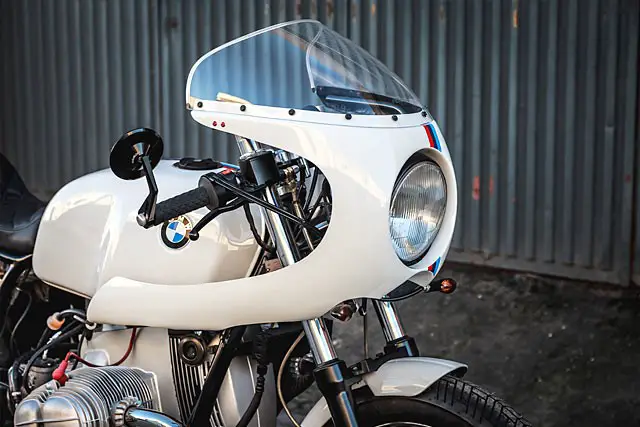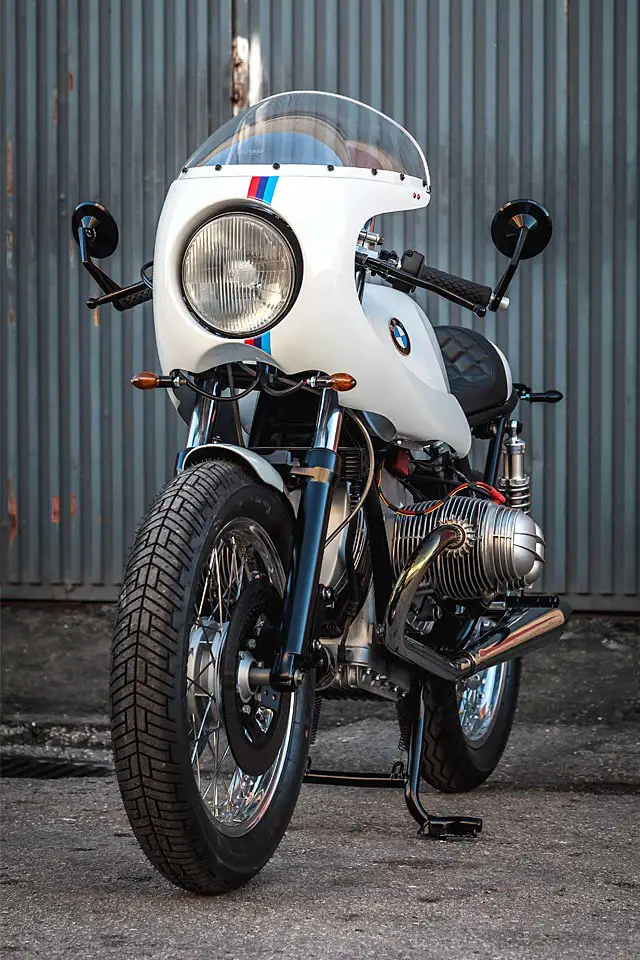How does a motorcycle achieve cult status such as that enjoyed by the R100 BMW café racer? In any of its many stock forms, the R100 was always a perfect example of purpose in design. Its elegance only elevated that purpose, with a level of refinement that few of its competitors could match. In competent hands, it could keep up with the Japanese superbikes of its era on any twisty road. Yet it did so in an effortless, gentlemanly way.
Quick Article Navigation
The Perfect Café Racer
The first version of this iconic machine was the 1976 R100/7. The slash seven was an improvement on the previous slash six version of the bulletproof BMW 247 engine. This is the classic flat-twin boxer engine, which is air-cooled – hence the nickname “airhead.” The R100/7 variant saw changes such as a deepened sump, beefed-up gearbox and lightened push rods. The R100 line would see continuing tweaks throughout its several runs.
Inherent Balance
What brings the 1000cc engine to heel is the inherent balance of its engine design. The opposing twin engine is inherently balanced. It produces a noticeable shudder upon cold starts, but that gives way to a pleasant hum once operating temperature is achieved. Other engine designs require a balance shaft to quell the vibrations that would otherwise shake their bolts loose, but the 247 engine needs no counterbalancing. The smoothness is innate.
Low CG
At 474 pounds, the R100 may be heavy by modern standards, but it was lithe for its day. It is a surprisingly agile motorcycle considering its age. That flickability is brought to you courtesy of a supremely low center of gravity, so low that the cylinder heads of the boxer engine sit nearly even with the axle. Mass is centralized, creating a tractable feeling as power is applied. That sensation of being in control never fades, all the up to the bike’s 117-mph top speed.
Classic BMW Architecture
The café racer is, regardless of platform, an exercise in aesthetics. The visual satisfaction you get from seeing one comes from its lines, and bike builders often have to work double time to pull those lines from a stock motorcycle. Not so for the R100 café racer. Here is a motorcycle that breathes sportiness. Even in stock form, its length evokes speed. It instantly takes on café guise when relieved of its stock seat and rear fender – clip-ons are optional. Just look at the typical BMW R100 café racer for sale, to get a feel for how easy the transformation really is.
Of course, bikes from the R100 line are not necessarily destined to become café racers. Many builders have produced some beautiful machines with simple restorations of stock R100s. And a BMW R100 scrambler is a sight to behold, though the classic upswept pipes of the genre require a builder who can bend some steel. The R100 most often becomes a café build simply because it lends itself to the design. But which versions make the best daily riders? There really is no wrong answer. Consider this beautiful R100RS racer.

This impeccable interpretation of the sporting version of the R100 comes via Spain’s Macco Motors. It is the result of a customer bringing in two R100RS bikes in various stages of disrepair. The minds at Macco took what worked from each bike, restoring one clean café racer from those parts. The finished product is more restoration than it is a concept build, but it shows how a café racer can flow from a stock R100, regardless of variant. Easy like Sunday morning.


Improvement Through the Years
Engine Modernization
The first R100 examples are classic to the extreme. Beginning in 1980, the old-style mechanical ignitions – complete with points and capacitor – were replaced with a more modern electronic ignition. Reliability has never been a BMW fault, and it wasn’t actually improved with the new ignition, but owner maintenance was reduced.
The following year, 1981, saw the introduction of Nikasil-lined cylinders, which reduced friction between piston and jug for smoother, cooler and ultimately faster operation. A lighter flywheel also helped provide a peppier RPM pickup. The result was a slightly improved quarter-mile time to below 13 seconds on the CS model, despite then-new emissions control measures.
Shaft Effect
The first version of the R100 was a creature of its times. Improvements came in fits and starts, beginning with torsional-dampened driveshafts on the 1979 model. Shaft-driven bikes tend to lift at the rear when power is applied and then squat when the throttle is released. This shaft effect – or shaft jacking – places unique demands on the rider during cornering that can be distracting and disconcerting for the uninitiated.
In 1986 BMW introduced Monolever (single-sided) swingarms on some models, which alleviated the shaft effect somewhat. In 1988 the R100GS variant got the new-and-improved Paralever system, which quelled shaft jacking, but it didn’t find its way onto a café-worthy design until the final version of the airhead: the 1992-1995 R100R. Finally, the shaft effect was (mostly) tamed, but only at the end of the air-cooled boxer’s run.
Brakes
The first models of the R100 line donned a floating-caliper, single-disc front brake with a convoluted and complicated cable-actuated master cylinder. By 1980, Brembo fixed-caliper, dual discs arrived to increase stopping power. A lever-actuated, bar-mounted master cylinder would remain for the life of the model line.
On the back end, things are more confusing. A single rear disc came and went throughout the production run, though the most up-to-date R100R Classic (1992 to 1995) retained the disc rear brake. Depending on the model and year, a rear drum may be present. Stopping power is affected by the omission or inclusion of the disc rear brake, as you would expect.
Conclusion
Regardless of the variant (the GS dual-sport models excepted), the bones of a fantastic café racer reside in each R100. Builders spend countless hours on other makes and models in an effort to chisel out the lines that are inherent to these venerable boxers. And you simply can’t buy the street cred that an airhead provides. Notoriously reliable and infamous for enabling long hours of high-speed cruising, the BMW R100 may be the perfect platform for these custom builds.
